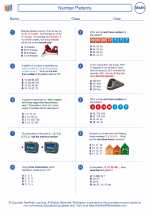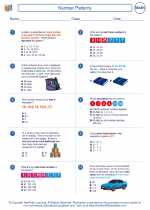Number Patterns -> sequences of numbers
Sequences of Numbers
A sequence is a list of numbers in a specific order. Each number in the sequence is called a term. Sequences can be finite (having a specific number of terms) or infinite (continuing indefinitely).
Types of Sequences
1. Arithmetic Sequence:
An arithmetic sequence is a sequence of numbers in which the difference between any two consecutive terms is constant. This constant difference is called the common difference. The general form of an arithmetic sequence is: an = a1 + (n-1)d, where an is the n-th term, a1 is the first term, n is the position of the term, and d is the common difference.
A geometric sequence is a sequence of numbers in which each term after the first is found by multiplying the previous term by a constant called the common ratio. The general form of a geometric sequence is: an = a1 * r(n-1), where an is the n-th term, a1 is the first term, n is the position of the term, and r is the common ratio.
The Fibonacci sequence is a series of numbers in which each number is the sum of the two preceding ones, usually starting with 0 and 1. The sequence starts as: 0, 1, 1, 2, 3, 5, 8, 13, 21, and so on.
Study Guide
Here are some key points to remember when studying sequences of numbers:
- Understand the difference between arithmetic and geometric sequences.
- Be able to identify the common difference in an arithmetic sequence and the common ratio in a geometric sequence.
- Practice finding specific terms in a sequence using the given formulas.
- Explore real-life examples of sequences, such as population growth, financial investments, or patterns in nature.
- Understand the concept of infinite sequences and their behavior.
Remember to practice solving problems related to sequences and to seek help if you encounter difficulties. Understanding sequences of numbers is important not only in math, but also in various fields such as computer science, finance, and engineering.
.◂Math Worksheets and Study Guides Sixth Grade. Number Patterns

 Worksheet/Answer key
Worksheet/Answer key
 Worksheet/Answer key
Worksheet/Answer key
 Worksheet/Answer key
Worksheet/Answer key
